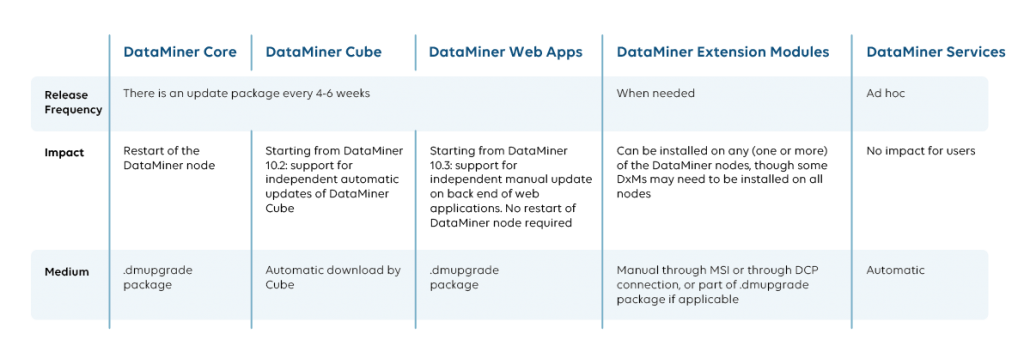DataMiner Releases & Updates
Release overview 2025-2026
The DataMiner platform development squads are using a release calendar to ensure timely and seamless releases. This webpage is designed to give you a comprehensive overview of the upcoming DataMiner updates.
Core DataMiner updates
What can you find on the calendar?
For every release you can find the release date and the period leading up to it, when the development teams are making code changes for it.
A typical cycle consists of:
- 4 weeks of development and testing (2 sprints of 2 weeks)
- 3 weeks of soak testing
- On the last Friday of those 3 weeks: version release
During this cycle, there are go/no-go decision points to see if a certain change has a negative impact on the release. If it does, and if we cannot safely fix it before the release date, the change gets reverted to make sure we can still release the other changes.
Here’s an example of how you should interpret the overview: DataMiner 10.5.8 will be released on July 11th. Development of new functionality and fixes for this version will be ongoing between May 23rd and June 20th. However, note that the development of larger features that take more time can already start earlier.

As we live in a VUCA world, the content of these releases is still to be defined.
Full upgrades
When the version is released, you can find the full DataMiner packages for both the Main as Feature release here.
Client updates
Next to the full-blown DataMiner updates, you can opt for regular Cube updates. This way you can use the latest Cube version even if you keep an older back end for a while. These so-called independent Cube updates can be used from DataMiner 10.2 onwards.
From DataMiner 10.3 onwards, the same functionality will also be available for our web applications. However, note that if you opt in for regular Cube updates, it all goes automatically, while for the web applications you will need to install the latest pack on the server manually.
Note: Updates on the web application from 10.5 onwards can only be deployed on DataMiners running at least the 10.4 version.
DxMs (DataMiner Extension Module)
Over the past years, we’ve been working on decoupling a few of the back-end functionalities to allow for more granular release of functionalities without the need to fully restart the DataMiner back end. This process will continue during the coming years, and you’ll see a better integration with dataminer.services to fine-tune it. The release cadence of these DxM packages can be more ad hoc but the development cycles are similar to those of the core DataMiner releases.
Dataminer.services
Our cloud environment can be updated at any time. It is a great way of leveraging new DataMiner services. Just like for the DxMs, the same development-test-release cycle is applied.
Update summary
Below you can find a handy overview of the different kinds of DataMiner updates, their frequency, their impact, and the way you can install them.
